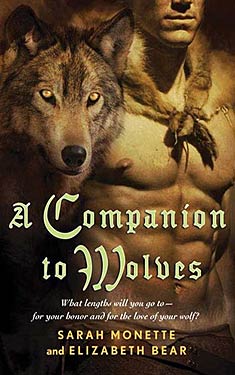Sarah
Monette and Elizabeth Bear
Completed
12/28/2019, Reviewed 12/29/2019
3 stars
This was a very peculiar book. It was a bit reminiscent of the “Dragonriders
of Pern” series, but with wolves instead of dragons and set in a Viking like
culture. Instead of threads, they fight
trolls and instead of it being an honor to be in this wolf community, it has fallen
into disfavor. What was most peculiar
about the book was that there is a lot of m/m sex, but there is almost no gay
content. The characters are mostly
straight, or maybe bisexual. Because the
men are psychically bonded with wolves, both male and female, the men have sex
with each other when the wolves do. So
if you’re expecting a m/m romance, this is not that book. It is sexual politics with no sexuality.
 The plot however was simple but interesting. Njall is the son of a powerful landholder who
is heir to his father and sexually active with women. One day a member of the wolf community comes with
his companion wolf and demands that the father, Gunnar, tithe his son to the
community as is the custom. Gunnar is
adamant that he will not for two reasons.
First, the community has fallen out of favor because the troll threat has
greatly lessened, and second, because of the rumors of the man on man sex that
happens. However, Njall is dramatically
drawn to the wolf, disobeys his father and joins the community. There, he takes a new name, Isolfr, and pairs
with a she-wolf who is destined to be a queen.
Together they fight a new wave of invading trolls.
The plot however was simple but interesting. Njall is the son of a powerful landholder who
is heir to his father and sexually active with women. One day a member of the wolf community comes with
his companion wolf and demands that the father, Gunnar, tithe his son to the
community as is the custom. Gunnar is
adamant that he will not for two reasons.
First, the community has fallen out of favor because the troll threat has
greatly lessened, and second, because of the rumors of the man on man sex that
happens. However, Njall is dramatically
drawn to the wolf, disobeys his father and joins the community. There, he takes a new name, Isolfr, and pairs
with a she-wolf who is destined to be a queen.
Together they fight a new wave of invading trolls.
Then it gets sexually weird.
When his she-wolf goes into heat, the male wolves become sexually
aroused. The same goes for the human
companions of the wolves. When the she-wolf
chooses a mate, the associated human companions also have sex. The thing is, Isolfr is basically straight
and is not interested in man on man sex.
However, because he is driven to a sexual frenzy by his wolf-sister, he
accepts the passive role, actively participating in it, but at the same time
wishing it were over. He never bonds
with his sexual partners. In fact, he is
promiscuous with the women who work in the community (in traditional women’s
roles) and even fathers a child with a local woman. I was a little uncomfortable with these
scenes. While there is consent, it is a
bit dubious. Isolfr and others bonded
with she-wolves accept their duties as their companions, but they are not necessarily
gay or even bisexual. It made for some
uncomfortable reading.
Another problem I had with the book is that there are a lot
of characters, human and wolf, and they all have difficult, unfamiliar
names. There is no real differentiation in
the names of each type, except that some of the men have “fr” at the end of
their names. I found it very
confusing. I often didn’t know who was a
man and who was a wolf. And the charater
development of the minor characters is not that great. So it was tough to tell who was through much of
the book.
The best things about the book are the world-building and
the trolls. The world-building is quite
extensive, being a Nordic-like culture with references to the Nordic gods and the
complexity of the social structure of community. The trolls are pretty cool and even they have
a social structure and some humanity, though that is not made evident until
late in the book.
I give this book three stars out of five for the
world-building and the trolls. It is a
highly readable book, though the myriad of names slowed me down some. The complexity of the wolf social structure
and their companions was really well done.
I think I could have given this four stars if it weren’t for the sexual
aspect.
No comments:
Post a Comment